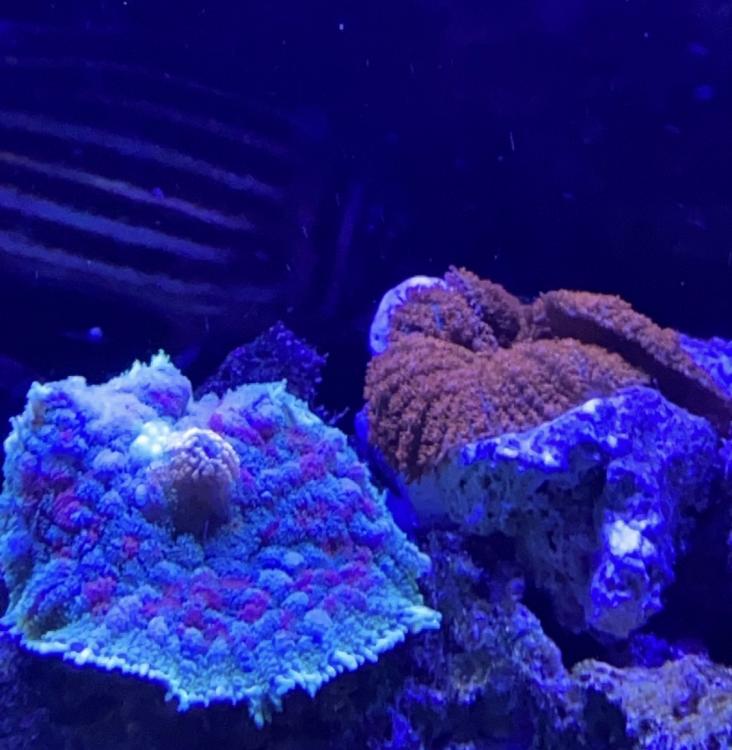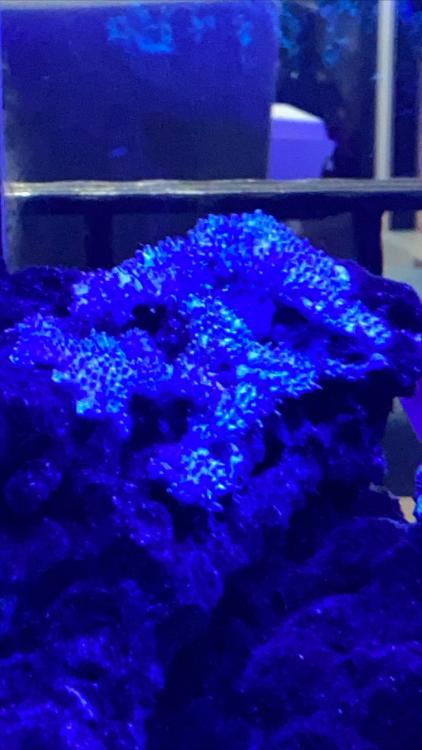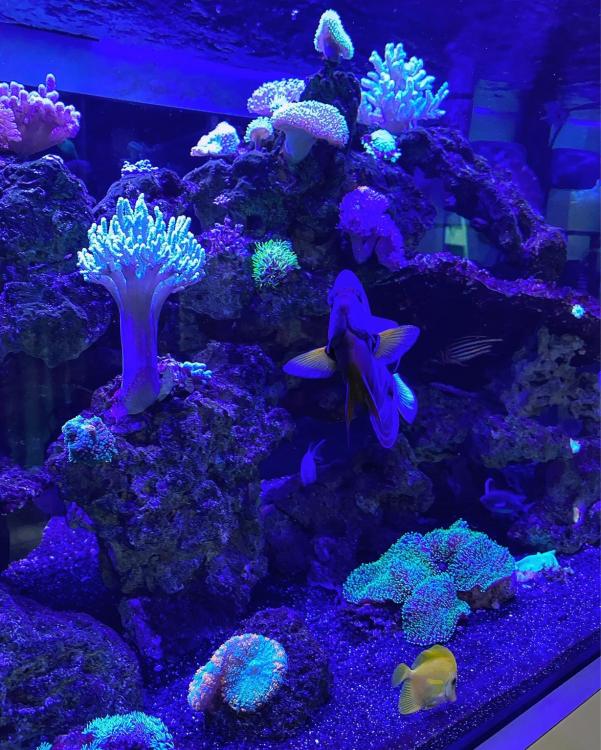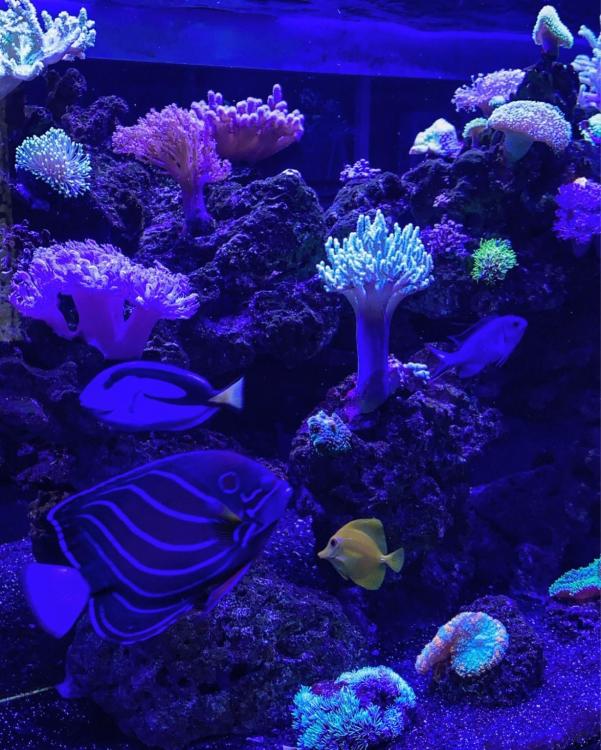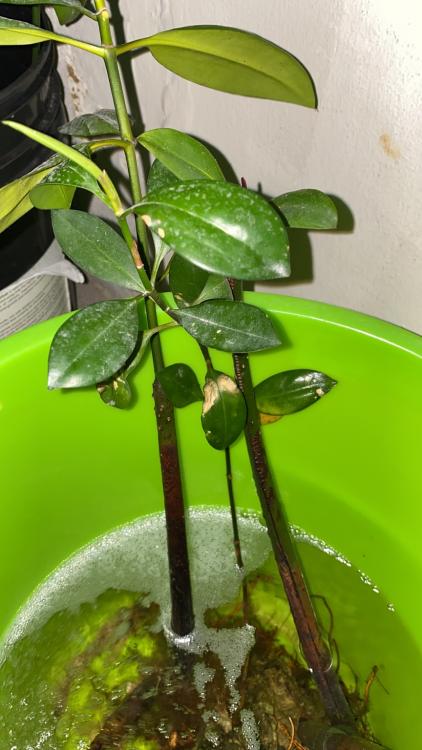-
Posts
1,067 -
Joined
-
Last visited
-
Days Won
20
Content Type
Profiles
Forums
Gallery
Everything posted by soggycookies
-

From FOWLR to Mixed Reef to Mangroves to Softies
soggycookies replied to soggycookies's topic in Members Tank & Specs
A shot of a couple of mushrooms(i believe one is a forest fire shroom) with one of my three redcoat squirrelfish(Sargocentron rubrum) taking refuge under the cavernous rockscape. They typically seek refuge in shaded areas of the tank during the day and tends to become more active before my lights ramp up and as they ramp down. Sent from Singapore Reef Club mobile app -

From FOWLR to Mixed Reef to Mangroves to Softies
soggycookies replied to soggycookies's topic in Members Tank & Specs
elaborating a little further on this: the regal angel i had that actively ate my gsp didn’t go after it while its polyps were out, but enjoyed tearing chunks of them off while they weren’t extended, like this: perhaps confused them for sponge matter. Sent from Singapore Reef Club mobile app -

From FOWLR to Mixed Reef to Mangroves to Softies
soggycookies replied to soggycookies's topic in Members Tank & Specs
so sorry for the very late response bro! I just saw this. I don’t have one at the moment, but I kept a cowfish back in my old 5ft for about 9months. I fed it chunks of prawn and algae sheets. it also ate pellets, but seemed to have a hard time keeping them in its mouth with the way it’s used to eating. Mine eventually died cause of tankmate incompatibility. After keeping 3 of them over the years, I realize if kept in a system that’s large enough(with activated carbon if you’re worried it might crash your tank, which mine never have) they are actually not as hard as many assume they are to keep, just avoid fast-swimming/numerous tankmates at all costs. they don’t do well in a system that had many other fish that can easily outcompete them for food or overwhelm them when they’re trying to feed. Sent from Singapore Reef Club mobile app -
doubt it’s a matter of temperature. i would avoid making too many changes if i were you. odds are they will take even longer to re-adjust Sent from Singapore Reef Club mobile app
-

From FOWLR to Mixed Reef to Mangroves to Softies
soggycookies replied to soggycookies's topic in Members Tank & Specs
Surface agitation helps a lot in preventing a layer of dust and tiny particles from all around the tank accumulating at the surface, which aside from being unsightly, also reduces the efficiency of your lighting and the PAR your corals receive! An easy way to create better surface agitation is having a flow nozzle or extension attached to your return line in your main display directed at or situated near the surface of the the water. If you have the newer generation of maxspect gyres(xf330/350 series), the flow directors included make it such that you can place these laminar flow wavemakers closer to the surface of the water without worrying about them blasting water out of your tank or creating vortexes above where they intake water. Personally I find gyre flow wavemakers very useful in eliminating deadspots in a tank, especially if the rockwork is already advantageously scaped to incorporate plenty of open caves for water to pass through and around. Sent from Singapore Reef Club mobile app -

From FOWLR to Mixed Reef to Mangroves to Softies
soggycookies replied to soggycookies's topic in Members Tank & Specs
Aside from chopped fresh seafood once a day, I feed the 17 fish in my main display 3-5 teaspoons of flakes a day and vitalis’ marine grazer occasionally(twice a week or so). Opted for flakes over pellets as they’re easier for most of my fish to spot over pellets especially when they sink cause I use black sand in my 300G. My annularis angelfish in particular absolutely loves the flakes. Definitely getting more of these Omega One flakes in the future. Cheap, nutritious and loved by my fish! Sent from Singapore Reef Club mobile app -

Setting up FOWLR tank.
soggycookies replied to yongjunzer's topic in FOWLR (Fish-only with Live-rock)
if you’re going with a fowlr setup, i suggest going as big as you can from the beginning since marine fish typically require more space than freshwater. also gets rid of the hassle of upgrading to a larger system in the future which is a tiring affair. that said, i’d only do this is i have experience keeping fish to begin with(basic tank cycling, salinity etc). otherwise you could consider a smaller 2ft tank and keep species-specific livestock like Frogfish. easy and low-maintenance fowlr setup. just feed it meaty seafood once every 2 days. Sent from Singapore Reef Club mobile app -
probably the new light having a different spectrum/wavelength variation from your older one. just leave the light settings consistent on your new one, if they’re healthy and your parameters are stable it should extend again in a week or two Sent from Singapore Reef Club mobile app
-
did you change your flow recently? ime acans dont like higher flow Sent from Singapore Reef Club mobile app
-

From FOWLR to Mixed Reef to Mangroves to Softies
soggycookies replied to soggycookies's topic in Members Tank & Specs
Some tiny leopard discosomas popped out of nowhere on this rock with a couple of elephant ears. A welcome surprise! Sent from Singapore Reef Club mobile app -

From FOWLR to Mixed Reef to Mangroves to Softies
soggycookies replied to soggycookies's topic in Members Tank & Specs
Fish Spotlight: Teira Batfish (Platax teira) One of the easier species of Batfish to keep in aquaria compared to the more delicate but prettier P. Pinnatus. Batfish IME are even less reef-safe than angelfish due to their voracious appetite, and will graze on coral as one of their food sources. As juveniles, they are very delicate and do not cope well in a boisterous setup with other more aggressive fish such as triggers, puffers, large angels and more stereotypical damsels. While shy in the beginning, they are not difficult to feed and can be easily hand-fed once they feel comfortable in their captive environment. They also grow rapidly during their juvenile to sub-sub adult stage until they reach about 8~11” in size, where their dorsal and anal fins at this point begin to shorten in vertical length. At these sizes, they’re great for large fowlr setups that feature other large peaceful to semi-aggressive species, but certainly not in reeftanks with coral. (Mine ate a 5” kenya tree and large mats of gsp) Sent from Singapore Reef Club mobile app -
lovely. looking forward to seeing your tank grow again! and glad the toadstool i got from you is doing well too Sent from Singapore Reef Club mobile app
-

From FOWLR to Mixed Reef to Mangroves to Softies
soggycookies replied to soggycookies's topic in Members Tank & Specs
Documenting the behavioural patterns of a self-collected blue-ring angel in a reef setting was a calculated risk I was apprehensive about initially but since I’m a bigger fan of fish than coral, I went with it anyway. (granted, I went through with this coming out of the forced decommissioning of an older system that crashed with leftover pieces of coral that weren’t doing great or I didn’t mind parting with) It’s been some time since I acquired this P. Annularis specimen and felt it best to keep coral stocking to a minimum ever since I decided to add it in a reef setting lest I burn my pocket. I began with a couple frags of hammers and a torch, some acans, mushrooms, a few assorted leathers and 2 rocks full of zoanthids. After 3 months, the 20x20cm rocks that were formerly covered in zoanthids were completely devoid of them. The hammers remained fine, but the few acans I had were gone too. The hammers, leathers and mushrooms were doing fine. The 1 torch that I had had receded into its skeleton, probably due to curious nips by my angel over time. Following this, I let my tank run as per normal without stocking up on any new corals for 6-8 months just to see if its behaviour would change or remain the same. Fed it chopped assorted seafood, and got it to eat flakes, but to this day it is still picky about what pellets it will eat. Thankfully, none of my leathers(toadstools and fingers) were harmed during this period, so earlier in 2020, I decided to add new softies to my display again. It’s been another 2-3 months since and so far, i’ve observed nothing but the occasional nip at a long-tentacle variant of xenia on days when the tank is fed very sparingly. I have since added a frag of clove polyps, a couple of new sinularias, new GSP, a few mushrooms and several different small toadstool frags. My angel has ignored the clove polyps for 3 months now, to my delight- allowing them to colonise more of the rockwork I placed the frag on. All in all I know having any kind of angel outside the genus genicanthus in a reeftank with corals is a risk, but I’m quite content with the equilibrium I’ve managed to create with my pomacanthus angel in a reef tank with mostly softies. She is now 9” long, chunky and adores flakes and market shrimp. The primary downside is zoanthids are a big no-no as long as she’s around. Meaty LPS like acans and scolys are probably going to be food as well, so those are out of the question- especially considering their generally higher prices. If she one day decided to mow down every coral in sight, I guess I’ll have no choice but to dedicate another system to those corals or sell them off, because this fish has become pretty priceless to me over the years. Sent from Singapore Reef Club mobile app -
appears to be some kind of filter-feeder, in which case it’s likely a species of tubeworm. or it could be a filter-feeding sponge or tunicate. virtually harmless to your system Sent from Singapore Reef Club mobile app
-
impressive volume of softies bro. cheers. thanks for sharing. hopefully some of my premium ones can grow out fast so we can trade softies hahahah Sent from Singapore Reef Club mobile app
-

From FOWLR to Mixed Reef to Mangroves to Softies
soggycookies replied to soggycookies's topic in Members Tank & Specs
My floral wrasse hiding amid my mini toadstool garden. please pardon the strong violet-wash in the photo -

From FOWLR to Mixed Reef to Mangroves to Softies
soggycookies replied to soggycookies's topic in Members Tank & Specs
Here’s a recovery shot of the stump of a toadstool I got early in March whose cap broke off from it. The stump has since begun to extend polyps of its own: And here’s what became of the toadstool cap that separated from its base: Sent from Singapore Reef Club mobile app -

From FOWLR to Mixed Reef to Mangroves to Softies
soggycookies replied to soggycookies's topic in Members Tank & Specs
-

From FOWLR to Mixed Reef to Mangroves to Softies
soggycookies replied to soggycookies's topic in Members Tank & Specs
Fish spotlight: Chain-line/Greyhead Wrasse(Halichoeres leucurus) A burrowing wrasse species that grows to about 12cm, this is a cousin of the likes of more popular aquarium fare such as H. melanurus. The coloration and body pattern between male and female specimens is very different, with female specimens closely resembling many other related burrowing wrasse species in the genus Halichoeres. The photos below are of a male & female specimen respectively, both photographed before introduction to my main system. The males are territorial against other males but can coexist peacefully with several other females as the alpha. Like most wrasses, they are a great coral-safe addition as a pest control option and spend the daytime prowling for small invetebrates and dig into the sand in the evening. Sent from Singapore Reef Club mobile app -

From FOWLR to Mixed Reef to Mangroves to Softies
soggycookies replied to soggycookies's topic in Members Tank & Specs
My old Map Puffer before I converted from a FOWLR setup. One of my favorite large puffers Sent from Singapore Reef Club mobile app -

From FOWLR to Mixed Reef to Mangroves to Softies
soggycookies replied to soggycookies's topic in Members Tank & Specs
Mangroves excreting salt via glands in their leaves. Notice the white blotches on their leaves. Typically when I see this, I make sure to spray/sprinkle slightly more freshwater on them to help with the natural process. Sent from Singapore Reef Club mobile app -

From FOWLR to Mixed Reef to Mangroves to Softies
soggycookies replied to soggycookies's topic in Members Tank & Specs
Turbo snails in my display spawning(releasing semen) into the water column at night: -
seems like anemones are far more sensitive to chemical changes from even these ‘reef-safe’ products than coral.. but i believe as long as you don’t see your anemone expelling its symbiotic algae which could bleach it(like one of mine did after i dosed polyplab medic to the main display and some of the globules landed on it), it should be alright Sent from Singapore Reef Club mobile app
-

white feather like thingy on the glass wall
soggycookies replied to Shoon82's topic in New to the Marine Aquaria Hobby
if those are nassarius snail eggs there should be nothing to worry about.. they’re great clean-up crew for your sandbed Sent from Singapore Reef Club mobile app -

white feather like thingy on the glass wall
soggycookies replied to Shoon82's topic in New to the Marine Aquaria Hobby
looks like a nudibranch. get it out of your system if possible. many species are coral predators Sent from Singapore Reef Club mobile app

